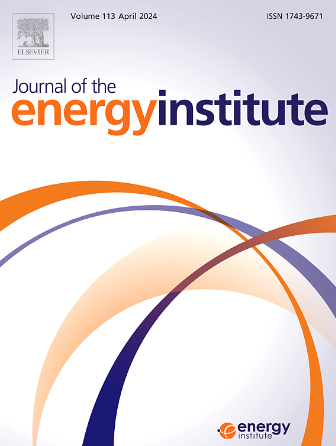Optimized preparation of biochar from large-particle biomass: analysis of process characteristics and structural evolution
IF 6.2
2区 工程技术
Q2 ENERGY & FUELS
引用次数: 0
Abstract
This study designed an online thermogravimetric analysis system to carry out pyrolysis investigation of large-particle biomass. The response surface method (RSM) was adopted for systematically exploring the influences of the particle size, pyrolysis temperature and residence time on the production and the heating properties of the biochar. The results reveal that the pyrolysis temperature has the most pronounced influence on the yield and the higher heating value (HHV) of the biochar, and the optimal biochar preparation condition is obtained with the particle size, pyrolysis temperature and residence time being 24 mm, 446 °C and 9 min separately. The real-time heating process and mass change of the large-particle biomass was revealed during the pyrolysis process. Different heating profiles are reported inside the biomass with the heating rate in the axial direction being faster than that of the radial direction. Moreover, the structural characteristics of the biochar granule at both axial and radial cross sections were analyzed with the Fourier Transform Infrared Spectroscopy (FTIR), Raman and Scanning Electron Microscopy (SEM). The produced biochar granule shows obvious non-uniformity. The ID/IG values in the axial and the radial quarter cross section are 3.72 and 3.56, respectively. Compared with the radial direction, more aromatic structures are formed in the axial direction. The results provide valuable insights for the preparation and practical application of biochar from large-particle biomass.

大颗粒生物质生物炭的优化制备:工艺特征及结构演变分析
本研究设计了一套在线热重分析系统,对大颗粒生物质进行热解研究。采用响应面法(RSM)系统探索了粒径、热解温度和停留时间对生物炭生产及加热性能的影响。结果表明,热解温度对生物炭产率和高热值(HHV)的影响最为显著,制备生物炭的最佳条件为粒径为24 mm,热解温度为446℃,停留时间为9 min。揭示了大颗粒生物质在热解过程中的实时升温过程和质量变化。不同的加热分布在生物质内部,轴向加热速率大于径向加热速率。利用傅里叶红外光谱(FTIR)、拉曼光谱(Raman)和扫描电镜(SEM)分析了生物炭颗粒在轴向和径向截面上的结构特征。所得生物炭颗粒表现出明显的不均匀性。轴向和径向截面的ID/IG值分别为3.72和3.56。与径向相比,轴向形成的芳香结构更多。研究结果为大颗粒生物质生物炭的制备和实际应用提供了有价值的见解。
本文章由计算机程序翻译,如有差异,请以英文原文为准。
求助全文
约1分钟内获得全文
求助全文
来源期刊

Journal of The Energy Institute
工程技术-能源与燃料
CiteScore
10.60
自引率
5.30%
发文量
166
审稿时长
16 days
期刊介绍:
The Journal of the Energy Institute provides peer reviewed coverage of original high quality research on energy, engineering and technology.The coverage is broad and the main areas of interest include:
Combustion engineering and associated technologies; process heating; power generation; engines and propulsion; emissions and environmental pollution control; clean coal technologies; carbon abatement technologies
Emissions and environmental pollution control; safety and hazards;
Clean coal technologies; carbon abatement technologies, including carbon capture and storage, CCS;
Petroleum engineering and fuel quality, including storage and transport
Alternative energy sources; biomass utilisation and biomass conversion technologies; energy from waste, incineration and recycling
Energy conversion, energy recovery and energy efficiency; space heating, fuel cells, heat pumps and cooling systems
Energy storage
The journal''s coverage reflects changes in energy technology that result from the transition to more efficient energy production and end use together with reduced carbon emission.
 求助内容:
求助内容: 应助结果提醒方式:
应助结果提醒方式:


